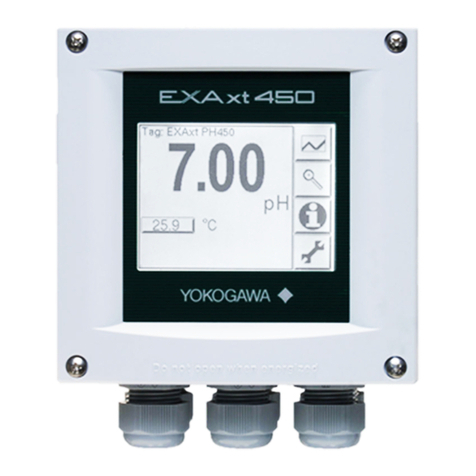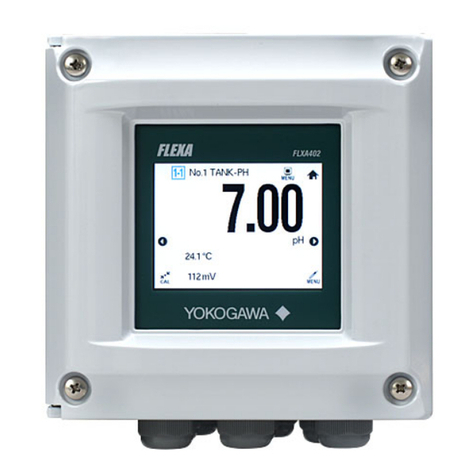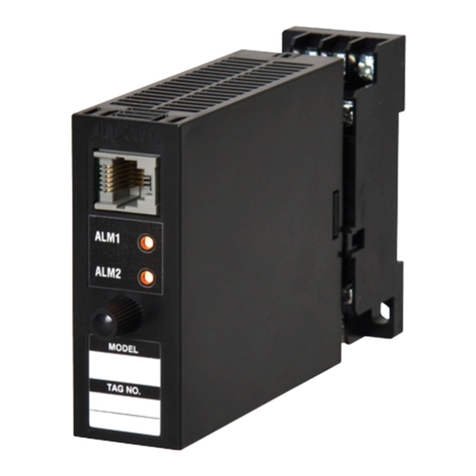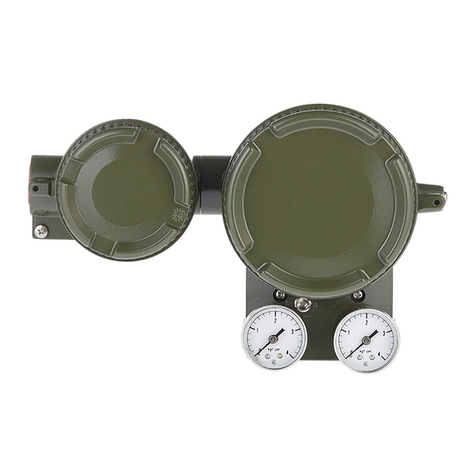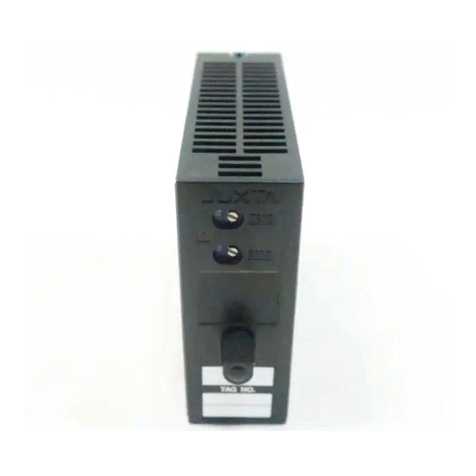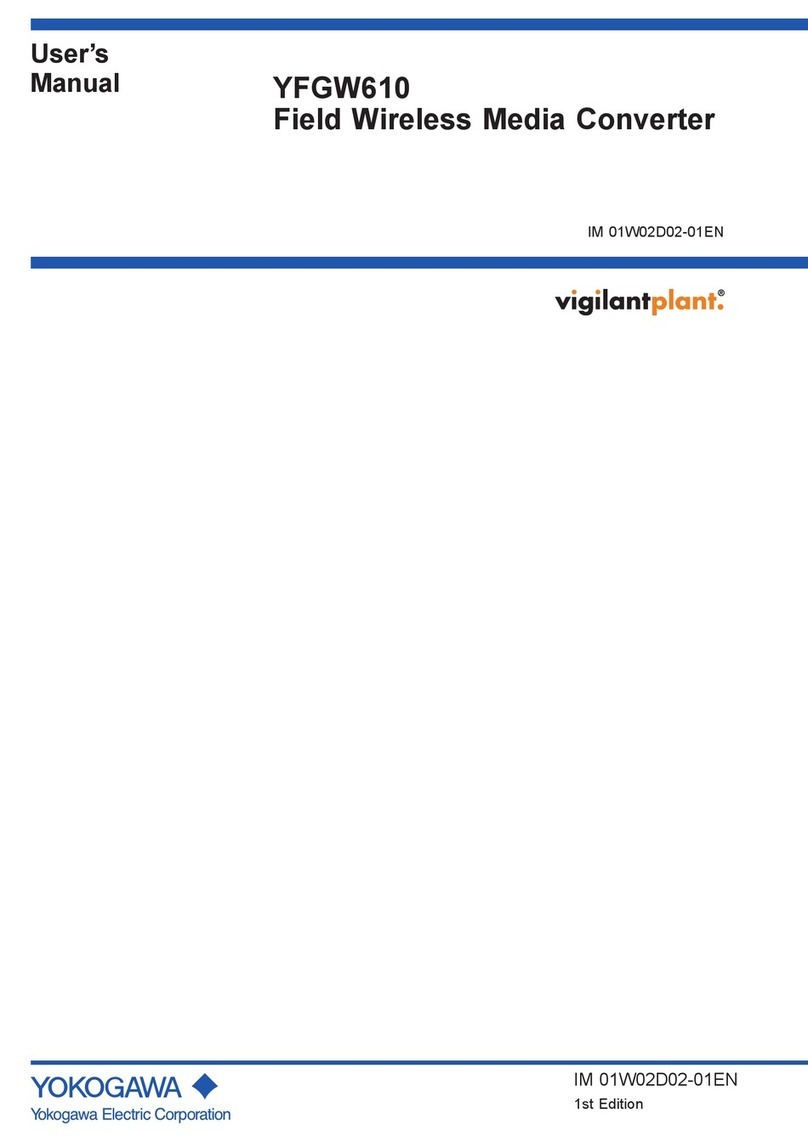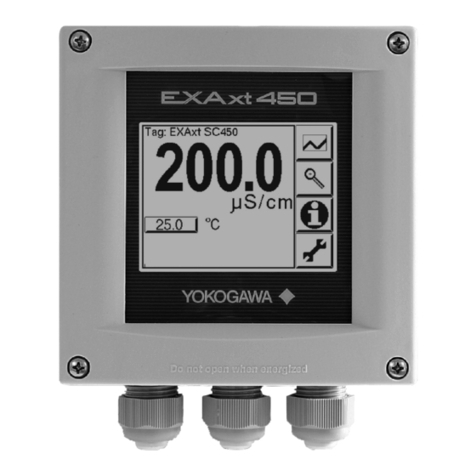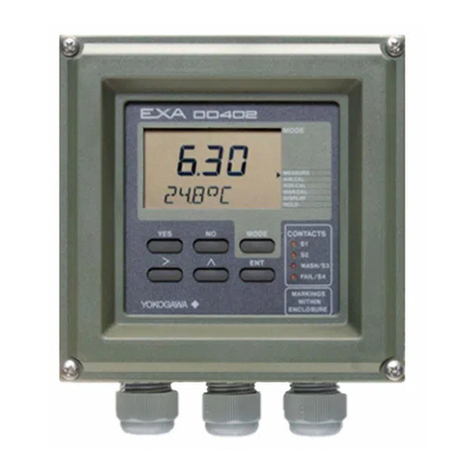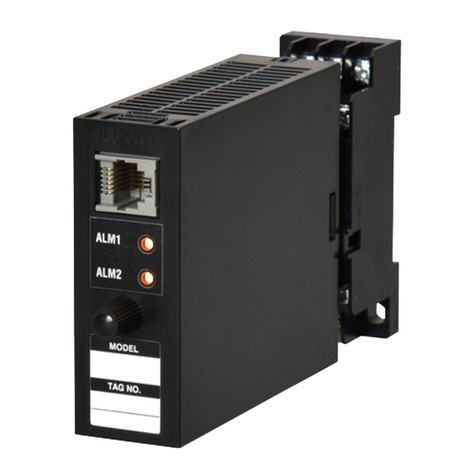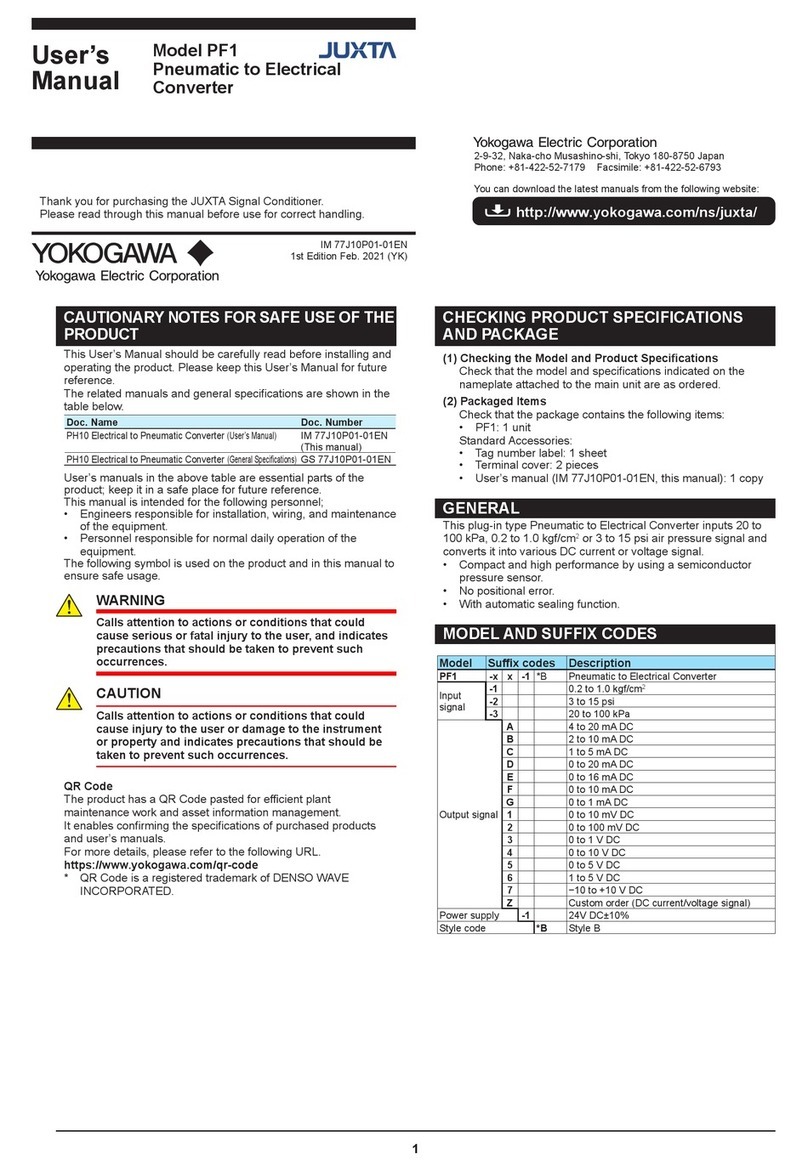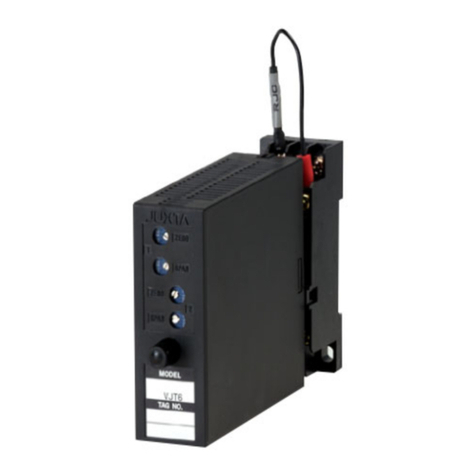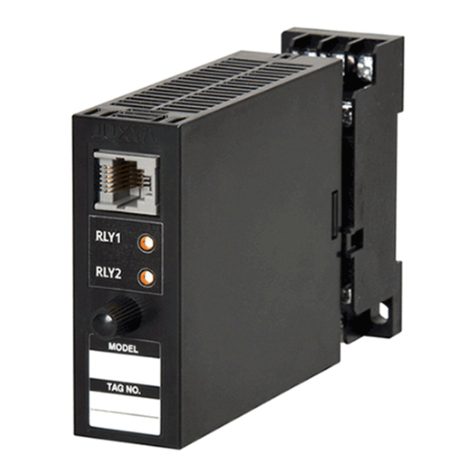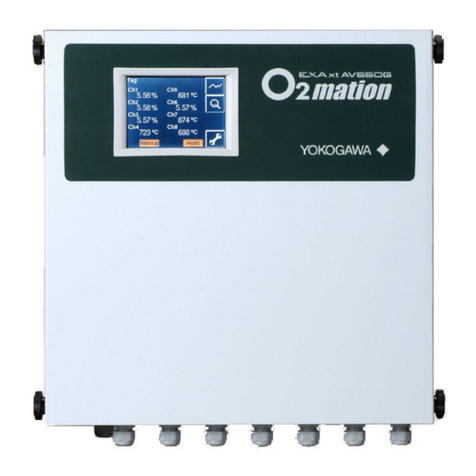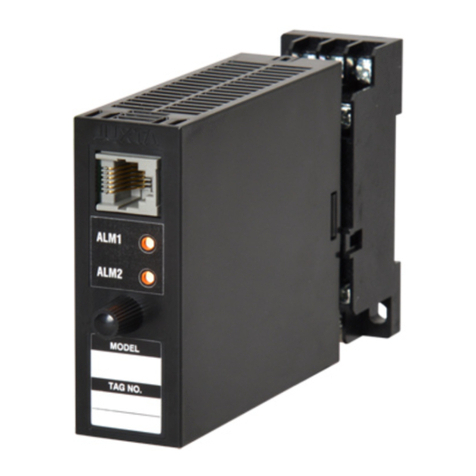
4IM 77J01Q08-01E 8th Edition
5. SETTING PARAMETERS
Set the parameters using a PC (VJ77 Parameter Setting Tool)
Refer to “8. LIST OF PARAMETERS” in this manual and the
User’s Manual for VJ77 PC-based Parameters Setting Tool (IM
77J01J77-01E) . Parameters are indicated inside the [ ].
5.1 Settings Related to Inputs and Outputs
5.1.1 Input Range Unit
When referring and setting the input range, select and set “Hz”
or “kHz” in [D20: UNIT]. Select “kHz” when input range is over
32000Hz.
5.1.2 Conversion Mode
Select and set the action of the instrument from “F/V
CONVERTER” (F/V conversion) or “INTEGRATOR” (pulse
integrator) in [D17: SELECT MODE].
F/V converter: Set when converting 0 to 100% of frequency
input to 0 to 100% of analog output, and
outputting it.
INTEGRATOR: Set when converting 0 to 100% of frequency
in put to 0 to 100% of analog output after
computing the average frequency from the
pulse number integrated per sample time, and
outputting it.
5.1.3 Sample Mode
Select and set “AUTO” or “MANUAL” in [D18: SAMPLE
MODE], when the conversion mode is set to “INTEGRATOR.”
AUTO: Outputs the sample time forcibly on the provided
MANUAL: Sets the sample time within setting range.
5.1.4 Sample Time
When the sample mode is set to “MANUAL”, set the sample
time in numerical value in [D19: SAMPLETIME].
• Sample time setting range: 0.1 to 100 seconds, by 0.1
second When the sample mode is set to “AUTO”, the
sample time is forcibly decided on the following conditions.
0.1 second when F100 (100% input frequency) is 1kHz or more
(1/F100) x 100 seconds when F100 is over 1Hz and below 1kHz
100 seconds when F100 is 1Hz or less.
5.1.5 Input Range
Set the 0% value of input range in [D24: INPUT1 L_RANGE],
and 100% of input range in [D25: INPUT1 H_RANGE] within
the numerically specied range.
CAUTION
In case the input range is changed after factory-ship,
the instrument may not work within the rated accuracy
range depending on the changed input range. Perform
the adjustment following the maintenance of this
instruction manual after changing the input range.
5.1.6 Input Low Cut Point
Set [D43: LOW CUT] to the low cut point.
Setting range: 0.01 Hz to F100 Hz (100% of input range)
If the input is less than or equal to the low cut point, the input is
0Hz.
5.1.7 Input Filter
When the chattering noise is generated in input, the input lter
is used to restrain the inuence. Select and set “ON” in [D58:
INPUT FILTER], then the input lter for time constant of about
10ms will be connected.
5.1.8 Direction of Output Action
Analog output signals can be reversed. To reverse the
signal from output-1, set [D50: OUT1 DR] to REVERSE. For
output-2, set [D51: OUT2 DR] to REVERSE. To return the
output-1 signal to normal, set [D50: OUT1 DR] to DIRECT.
For output-2, set [D51: OUT2 DR] to DIRECT.
5.2 Settings Related to Communication
Function
Set the following parameters when output-2 is specied
for communication function. For more information on the
communication function, see the Instruction Manual for VJ Series
Communication Function (IM 77J1J11-01E).
5.2.1 Communication Protocol
Set the communication protocol by selecting from among
PCLINK, PC-LINK WITH SUM, MODBUS ASCII, MODBUS
RTU, and LADDER in [F01: PROTOCOL].
5.2.2 Communication Address
Set the address number of the isolator numerically in a range
of 1 to 99 in [F02: ADDRESS].
5.2.3 Baud Rate
Set the baud rate by selecting from among 1200, 2400, 4800,
9600, 19200, and 38400 bps in [F03: BAUD RATE].
5.2.4 Parity
Select and set NONE, EVEN, or ODD in [F04: PARITY].
5.2.5 Data Length
Select and set 7 bits or 8 bits in [F05: DATA LEN].
5.2.6 Stop Bit
Select and set 1 bit or 2 bits in [F06: STOP BIT].
5.2.7 Input Decimal Point Position
Number of digits of decimal places (setting of D register
[D0003]) can be set.
Select and set among 0 to 5 digits in [F07: INPUT DEC PT].
5.3 Settings Related to Alarm Output
Set the following parameters when output-2 is specied for alarm
output.
5.3.1 Alarm Setpoints
Set the alarm setpoints of alarm-1 and alarm-2 in [E01: SET
POINT1] and [E04: SET POINT2] numerically.
• Setting range: A range of 0 to 100% of input range
• Setting resolution: 0.1%
5.3.2 Direction of Alarm Action
Select the direction of alarm-1 action and that of alarm-2
action from among HIGH ALM (high-limit alarm) and LOW
ALM (low-limit alarm) and set each in [E05: ALM1 ACTION]
(direction of alarm-1 action) or [E06: ALM2 ACTION](direction
of alarm-2 action).
• To activate alarm status when input signal ≥ alarm setpoint,
select HIGH ALM.
• To activate alarm status when input signal ≤ alarm setpoint,
select LOW ALM.
5.3.3 Hysteresis
Set alarm-1 and alarm-2 hysteresis, in [E09: HYSTERESIS1]
and[E10: HYSTERESIS2]. Hysteresis is a value added to the
alarm setpoint in order for an alarm status to be released (to
normal) after the alarm status has been activated. The alarm
status will be released in the following conditions, depending
on the direction of alarm action.
* When HIGH ALM (high-limit alarm) is set: Alarm is released
when input signal < (alarm setpoint - hysteresis).
* When LOW ALM (low-limit alarm) is set: Alarm is released
when input signal > (alarm setpoint + hysteresis).
• Setting range: A range of 0 to 100% of input range
• Setting resolution: 0.1%
5.3.4 Alarm ON Delay and Alarm OFF Delay
Set alarm-1 and alarm-2 ON delays in [E11: ON DELAY1] and
[E12:ON DELAY2] and then alarm-1 and alarm-2 OFF delays
in [E131: OFF DELLAY1] and [E14: OFF DELAY2]. An alarm
ON delay is a delay time from the establishment of alarm
condition to alarm output; an alarm OFF delay is a delay time
from the establishment of return-to-normal condition to output.
• Setting range: 0 to 999 seconds
• Setting resolution: 1 second (Note that about 0.2 second
will be added to set time to prevent erroneous operation.)
For example, when an alarm ON delay is set to 1 second,
alarm output is generated if alarm status continues for
more than 1 second after the input value exceeds the
alarm setpoint. Further, when an alarm OFF delay is set
to 2 seconds, alarm output is released if normal condition
continues for more than 2 seconds after the input value has
returned to normal from the alarm status.
5.3.5 Direction of Relay Action
Set the direction of relay energizing in alarm-1 normal
condition and alarm-2 normal condition by selecting from
among NRM DEENERGIZED (de-energized under normal
condition) and NRM ENERGIZED (energized under normal
condition) in [E15: RL1 ACTION] and [E16: RL2 ACTION]
and set them.

